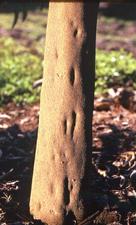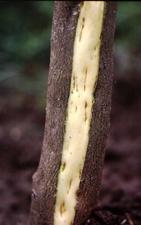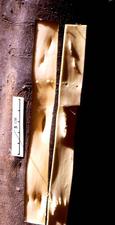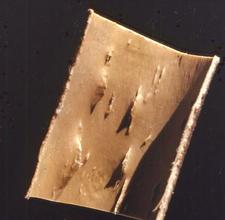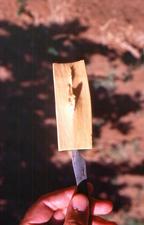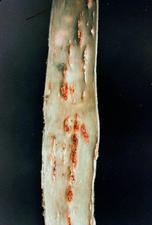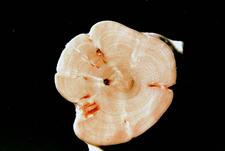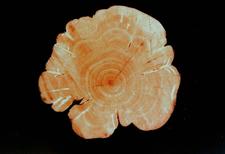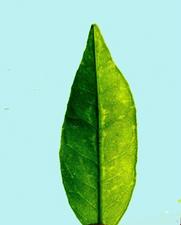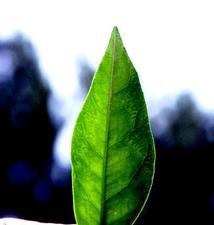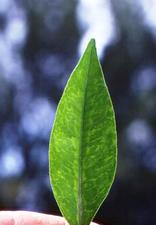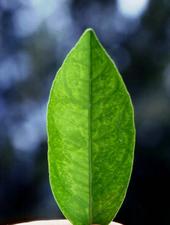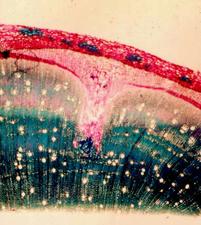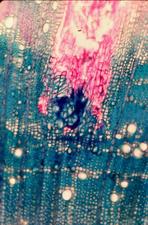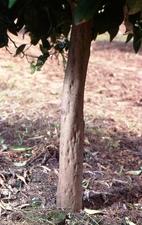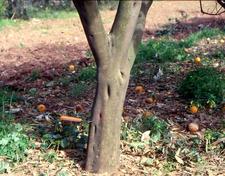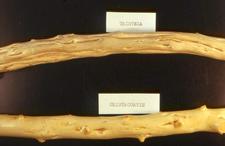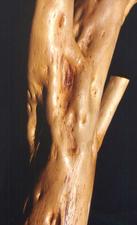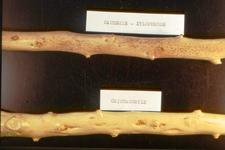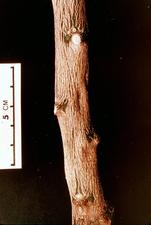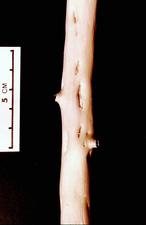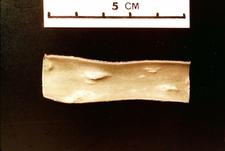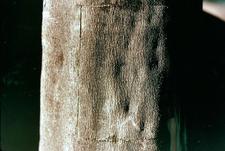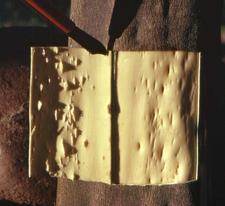Cristacortis
HISTORY, DISTRIBUTION AND IMPORTANCE
Described by Vogel & Bové (1964) in Corsica, on Tarocco sweet orange trees grafted on sour orange.
Found in Corsica, Sicily, Sardinia, Spain, Morocco, Algeria, Egypt, Turkeyand Mauritius. Also found in the State of Sao Paulo (Brazil) on a sweet orange tree on sour orange top grafted with imported clementine budwood (Rossetti & Bové, 1975; unpublished). A non-destructive disease, in spite of severe stem pitting symptoms. No data on economic importance.
NAME OF DISEASE AND SYNONYMS
Cristacortis, from the latin: crista=peg, and cortis=bark (Vogel & Bové, 1968). Sour orange stem pitting (Scaramuzzi &Catara, 1968). Tarocco orange stem pitting (Vogel & Bové, 1964).
Abbreviation: Cr for Cristacortis.
SYMPTOMATOLOGY
General aspect of affected field tree
Normal or slightly stunted.
Symptoms on trunk (on rootstock and/or scion), limbs and shoots
Vertical depressions or pockets (Cr. 01) due to pits in the wood (Cr. 02, 03) with corresponding pegs on cambial side of bark (Cr. 03, 04, 05). With certain species such as tangelos, gum-like material stains the tissues at top of peg (Cr. 06) and bottom of pit (Cr. 07, 08). Depressions, even severe, can disappear with time as a consequence of radial growth. However, traces of previous depressions and pitting remain buried in wood, and can be seen in cross-sections, as radially oriented clear, whitish lines (Cr. 08, 09). Although old depressions disappear, new pits and pegs develop anywhere on tree. On newly infected tree, place where first symptoms appear is unpredictable.
Symptoms on leaves
Flecking and oak leaf pattern on young leaves similar to Psorosis-Concave gum-Blind Pocket leaf symptoms (Cr. 10, 11, 12, 13) (Vogel & Bové, 1974).
Symptoms on fruit
None.
Histological and cytological symptoms
Young pits in the wood can occur without accompanying external depressions (Cr. 14). Disorganization of cambial zone (Cr. 14, 15, 16). No cytological symptoms reported.
CAUSAL AGENT: DESCRIPTION AND PROPERTIES
The causal agent is easily graft-transmissible, but its nature is unknown. Certain field isolates produce symptoms on clementine trees, others do not.
HOST RANGE
Thus far, restricted to Citrus spp.; non-rutaceous hosts: unknown.
Sensitive species, varieties or combinations
Tangelo, tangor, sour orange, sweet orange, mandarin, clementine, grapefruit, rough lemon, Satsuma, siamelo, sweet lime, Citrus pectinifera.
Symptomless species, varieties or combinations
· Immune: none described
· Tolerant (symptomless carrier): “Eureka” lemon, West Indian lime, “Etrog” citron, Combava (Citrus hystrix), Poncirus trifoliata.
· Not determined whether immune or tolerant: no symptoms ten years after inoculaton of Troyer citrange, bergamot orange, volkamer lemon.
TRANSMISSION
Natural
Cultural transmission through budwood.
No evidence for vector transmission.
Experimental
Graft inoculation with shoots, buds, bark from shoots or roots, leaf patches: high percentage of transmission.
Mechanical transmission: unsuccessful.
Pollen form a critacortis-affected Orlando tangelo tree, and placed under the bark of healthy Orlando tangelo seedlings, was able to transmit both psorosis young leaf symptoms and the typical cristacortis stem-pitting (Cr. 17). However natural spread of cistacortis by pollen has never been observed (Vogel & Bové, 1976, 1980).
EPIDEMIOLOGY
Not studied.
DIAGNOSIS
Diagnostic field symptoms
Depressions, pockets, and stem pitting in trunk, limbs, and shoots. When susceptible species or varieties are grafted on sour orange, one should look for stem pitting on both scion and rootstock. The presence of stem pitting on the sour orange stock in addition to pits on the scion is valuable for diagnosis (Cr. 18).
Comparison with other diseases
Especially on young shoots, stem pitting somewhat similar to that of Tristeza on Mexican lime (Cr. 19). Cristacortis is not related to Tristeza because Mexican lime does not react to Cristacortis and behaves like a symptomless carrier; also because cristacortis-affected trees on sour orange do not show tristeza-like decline.
Depressions due to blind pocket - concave gum, are quite different from those of cristacortis (Cr. 20, 21, 22), and only those of Cristacortis are accompanied by pits in the wood and corresponding pegs on the cambial side of the bark (Cr. 02, 03, 04, 05,06). Cristacortis affects sour orange but blind pocket and concave gum do not. With cristacortis, traces of previous pitting remain burried in the wood and can be seen on cross sections as radially oriented lines (Cr.08, 09). With concave gum - blind pocket, no radially oriented traces are seen, but several rings of wood are stained brownish, giving a concentric type of staining (Cr. 20, 21, 22) (see also Concave gum – Blind pocket, CG-BP).
Cristacortis and cachexia have an overlapping host range, but on common hosts e.g., Olando tangelo, symptoms are different (Cr. 23).
On certain hybrid seedlings, cristacortis-like stem pitting develops, but is not graft-transmissible.
Biological indexing
· Indicator plant and inoculum: Orlando, Webber or Williams tangelo on sour orange. The tangelo bud and the two inoculum bark patches are grafted at the same time on the sour orange seedling, one bark patch above and the other below the tangelo bud; three indicator plants per candidate-tree. Alternative indicators: tangelo seedlings can also be used as test plants.
· Observed symptoms: vertical depressions or pockets on stem and shoot on one or both partners of indicator plant (Cr. 24). Pits in the wood (Cr. 25), pegs on the cambial side of the bark (Cr. 26). Cristacortis symptoms on Orlando tangelo trunk before (Cr. 27) and after (Cr. 28) removal of bark
· Incubation and development of symptoms: generally 12 to 18 months after inoculation; with certain candidate-trees such as clementine, symptoms may appear only after several years. Symptomless test plants are kept five years. Test plants should be grown so as to favour radial growth; symptoms seem to be poor under greenhouse conditions. Cristacortis and cachexia can be indexed on the same Orlando tangelo on sour orange test plants since Orlando tangelo reacts differently to the two diseases and sour orange is only sensitive to cristacortis.
Serological and molecular diagnostic methods
None available.
CONTROL
Use of cristacortis-free budwood.
SELECTED REFERENCES
Servazzi, O., F. Marras, A. Foddai (1968). Investigations on citrus cristacortis in Sardinia. p. 229-231. In J.F.L. Childs (ed.) Proc. 4th Conf. Intern. Organization Citrus Virol., Univ. Florida Press, Gainesville.
Scaramuzzi, G., A.A. Catara (1968). Studies on sour orange stem pitting in Sicily. p. 201-205. In J.F.L. Childs (ed.) Proc. 4th Conf. Intern. Organization Citrus Virol., Univ. Florida Press, Gainesville.
Vogel, R. (1973). Le Cristacortis, une nouvelle maladie a virus des agrumes. Thèse de Doctorat d’Etat de l’université de Bordeaux 2, 153 pp. nº d’enregistrement au C.N.R.S: AO 9823.
Vogel, R., J.M. Bové (1964). Stem pitting sur bigaradier et sur oranger Tarocco en Corse: une maladie à virus. Fruits, 19: 264-274.
Vogel, R., J.M. Bové (1968). Cristacortis, a virus disease inducing stem pitting on sour orange and other citrus species. p. 221-228. In J.F.L. Childs (ed.) Proc. 4th Conf. Intern. Organization Citrus Virol., Univ. Florida Press, Gainesville.
Vogel, R., J.M. Bové (1972). Further experiments on Cristacortis disease. p. 178-184. In W.C. Price (ed.) Proc 5th Conf. Intern. Organization Citrus Virol. Univ. Florida Press, Gainesville.
Vogel, R., J.M. Bové (1974). Studies on the cause of leaf symptoms associated with cristacortis disease of citrus. p. 131-143. In L.G. Weathers & M. Cohen (eds) Proc. 6th Conf. Intern. Organization Citrus Virol., Univ. California, Division Agricultural Sciences.
Vogel, R., J.M. Bové (1976). Transmission de maladies infectieuses d’agrumes à agrumes par le pollen d’arbres appliqué sous l’écorce de plantes saines. C.R. Acd. Sci. Paris, série D, 283, 1409-1412.
Vogel, R., J.M. Bové (1980). Pollen transmission to citrus of the agent inducing cristacortis stem pitting and psorosis young leaf symptoms. p. 188-190. In E.C. Calavan, S.M. Garnsey and L.W. Timmer (eds) Proc. 8th Conf. Intern. Organization Citrus Virol., Univ. California, Riversiide.
Prepared (1980) by R. Vogel
Station de Recherches Agrumicoles,
(I.N.R.A. – I.F.A.C.)
San Giuliano,
20 230 – SAN NICOLAO,
(France)
Revised (2008) by J.M. Bové
IBVM, Laboratoire de Biologie Cellulaire and Moleculaire,
I.N.R.A./ Université de Bordeaux 2,
Centre INRA de Bordeaux,
71, Ave. E. Bourleau,
33883 – Villenave d’Ornon,
(France)
Click any image to see it larger.
PHOTOS |
LEGENDS AND AUTHORS |
|---|---|
|
Vertical depressions on trunk of Orlando tangelo seedling tree inoculated with the cristacortis agent. (Corsica) – R. Vogel
|
|
|
Pits in the wood of a young Tarocco sweet orange tree infected with the cristacortis agent. (Corsica) – J.M. Bové
|
|
|
Pits in the wood and pegs on the bark of a Cadenera sweet orange tree inoculated with the cristacortis agent. (Corsica) – R. Vogel
|
|
|
Pegs on cambial side of bark from a sour orange seedling inoculated with the cristacortis agent. (Corsica) – R. Vogel
|
|
|
Typical cristacortis pegs on cambial side of bark from a Willow leaf mandarin of Italian origin (Antalya, Turkey) – J.M. Bové
|
|
|
Pegs on cambial side of bark from a Weber tangelo seedling inoculated with the cristacortis agent. Notice orange-stained, gum-like material on pegs. (Corsica) – R. Vogel
|
|
|
Pits in the trunk of a Webber tangelo seedling inoculated with the cristacortis agent. Notice the gum-like material in bottom of pits. (Corsica) – R. Vogel
|
|
|
Cross section through an Orlando tangelo branch from a tree inoculated with the cristacortis agent. Notice gum-like material in bottom of pits, sometimes deeply buried in the wood. Notice also the radial traces (clear-coloured zones) left by pit formation. Gum material sometimes stains these traces. (Corsica) – R. Vogel
|
|
|
Cross section through Webber tangelo branch affected by cristacortis. Notice again the radial traces left by the pits. Less gum deposit than with Orlando tangelo. (Corsica) – R. Vogel
|
|
|
Flecking and oak leaf pattern on clementine leaf from a cristacortis affected tree. (Corsica) – J.M. Bové
|
|
|
Clementine leaf with cristacortis induced vein flecking on margins and oak leaf patterns on each side of midrib (S.R.A., Corsica) – J.M. Bové
|
|
|
Same as Cr 11
|
|
|
Same as Cr 11
|
|
|
Light micrograph of a cross section through a young Orlando tangelo shoot from a cristacortis affected tree. Notice formation of pit and peg by disorganization of cambial zone. No sign of pit formation is yet visible from the outside. Wood material is stained green-blue. Bark material stains red. (Versailles, France) – D. Laflèche
|
|
|
Close up of pit and peg of Cr. 14. Pit is due to invasion of wood by disorganized bark-like material (peg). (Versailles, France) – D. Laflèche
|
|
|
Same as Cr. 14 but at a later stage of pit formation. A depression is now visible from the outside. (Versailles, France) – D. Laflèche
|
|
|
Cristacortis stem pitting on Orlando tangelo seedling experimentally inoculated with pollen from a cristacortis infected Orlando tangelo (S.R.A., Corsica) – J.M. Bové
|
|
|
Verna sweet orange tree on sour orange graft inoculated with the cristacortis agent and showing stem pitting on both scion (above knife) and stock (below knife) (S.R.A., Corsica) – J.M. Bové
|
|
|
Tristeza stem pitting on Mexican lime and cristacortis stem pitting on Orlando Tangelo. (Corsica) – R. Vogel
|
|
|
Left: Cross section through concave gum affected Orlando tangelo. Notice concave gum depressions and fine concentric layers of wood stained with gum. Right: Cross section through cristacortis affected Orlando tangelo branch. No gum layers. Notice the pits and the radial traces left by older pits. (Corsica) – R. Vogel
|
|
|
Cross section through an Orlando tangelo branch affected by both concave gum and cristacortis. Notice the presence of both concentric gum layers and radial pits. (Corsica) – R. Vogel
|
|
|
Orlando tangelo inoculated with both concave gum and cristacortis agents. Notice concave gum concavities and cristacortis pits. (Corsica) – R. Vogel
|
|
|
Cachexia stem pitting and cristacortis stem pitting on Orlando Tangelo. (Corsica) – R. Vogel
|
|
|
Small depressions on Orlando tangelo seedling inoculated with the cristacortis agent. (Corsica) – R. Vogel
|
|
|
Orlando tangelo seedling inoculated with the cristacortis agent, showing pitting after removal of bark. (Corsica) – R. Vogel
|
|
|
Pegs on inner side of bark removed from an Orlando tangelo seedling inoculated with the cristacortis agent. (Corsica) – R. Vogel
|
|
|
Cristacortis symptoms on Orlando tangelo trunk before removal of bark. (Corsica) – R. Vogel
|
|
|
Same as Cr. 27 after removal of bark showing pits in wood and pegs on cambial side of bark. (Corsica) – R. Vogel
|

